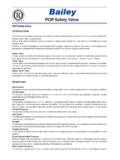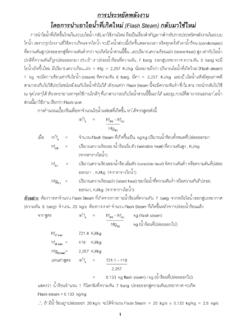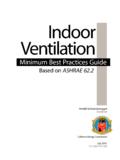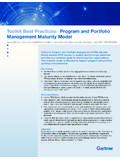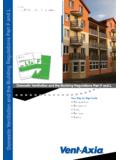Transcription of Steam System Best Practices Document No. 7 888 …
1 Plant Support & Evaluations, Inc 400 Lombardi Ave. Green Bay, WI 54304 888-615-3559 Fax: 888-615-8664 Plant Support & Evaluations, Inc 1 Steam System best Practices Document No. 7 Flash Steam Are You Venting (Flash) Steam to Atmosphere? With Today s Fuel Cost, Plants Can Not Afford to Allow Steam To Be Release to Why does flash occur? For any given saturated Steam or condensate pressure, there can be only the specific values listed in the Steam tables for temperature, sensible heat, latent heat, and specific volume. Condensate at a given pressure, discharged into an area of lower pressure, automatically adjusts the condensate temperature to the saturated conditions and other values at the lower pressure.
2 A specific amount of heat energy is released for each lower pressure condition and the heat energy that is release causes an effect that is called flash Steam , which is a percentage of condensate being re-evaporated into flash Steam at the lower pressure. This phenomenon is called flashing and the resultant Steam is called flash Steam . Review: High pressure condensate (higher energy content) discharging through a Steam trap, control valve, or other device to a lower pressure area (condensate return line, flash tank, or other System ), the condensate liquid temperature must be at the saturated conditions of the lower pressure.
3 To reduce the temperature of the condensate at the lower pressure, a percentage of the condensate is flash into the Steam . Plant Support & Evaluations, Inc 2 What is the Quantity of Flash? The Steam tables indicate that each pound of condensate at 7 bar contains 309 BTU s (sensible energy) and at 0 bar or atmospheric pressure condensate contains 180 BTU s (sensible energy). The high-pressure condensate, therefore, contains 309 Btu s (7 bar) sensible energy 180 Btu s (-1 bar) or 129 Btu s more Btu s than it can embrace at atmospheric conditions. To put this in terms of energy conservation, 129 Btu s of heat energy are released into the atmosphere and wasted from each pound of condensate returned to the boiler operation; if not recovered in the condensate System .
4 Since the latent heat of Steam at atmospheric pressure (-1 bar) is 970 Btu per pound of Steam at atmospheric conditions; the following equation would indicate how many pounds of Steam would be produced: 129 = lb. 970 That lb of Steam will be liberated or flashed off each pound of condensate returned at atmospheric conditions. The flash loss can be calculated for any condition by solving the following formula: % Flash Steam = (SH SL) x 100 LHL SH = Sensible heat in condensate at higher pressure SL = Sensible heat in condensate at lower pressure LHL = Latent heat in the Steam at the lower pressure to which the condensate has been discharged Flash Steam effects: 1.
5 Condensate return lines sizing 2. Condensate receiver tank vent sizing Plant Support & Evaluations, Inc 3 3. Steam System testing 4. Steam trap discharge piping 5. Energy loss 6. Increased chemical cost 7. Increased make-up water usage 8. Can cause waterhammer; if not properly piped In the piping sections there will be a discussion regarding how to size condensate return lines for the flash Steam . Flash Steam Recovery Systems (Non-modulating Steam conditions) Condensate/flash Steam (two phase flow) discharging from a non-modulating Steam System process can be recovered in a flash Steam System or high pressure condensate return System .
6 Non-modulating Steam condition; means there is no control valve modulating Steam flow to the process to maintain a desire temperature or pressure. A process Steam System that does not have an modulating Steam control scheme for the process provides a constant Steam pressure to the process; thus providing a constant pressure differential across the Steam traps or condensate discharge control valve. Flash Steam from the condensate discharge can be directed to another lower pressure Steam user for consumption. In a high pressure condensate return System , the percentage of flash Steam is greatly reduced by the high pressure condensate return line and typically the flash Steam is used for the deaerator Steam consumption.
7 Examples of Non-Modulating Steam Processes: Steam Tracing Drip Leg Steam Traps Unit Heaters Process Heater Re-boilers Corrugators Process heaters Etc. Plant Support & Evaluations, Inc 4 Flash recovery System The above System does not have a modulating Steam control scheme for the process, therefore there is always a constant Steam pressure to the process; thus providing a constant pressure differential across the Steam traps. With proper sizing and installation of a flash tank, the latent heat content of flash Steam may be used for any heat exchange device to heat air, water, or any other liquid or directly in processes with lower pressure Steam requirements.
8 Although flash Steam can be generated directly by discharging high-pressure condensate to a lower pressure Steam System , best Practices is to use a flash tank to control flashing. Flash tanks can be mounted either vertically or horizontally, but the vertical arrangement shown below is the preferred method; because it provides better separation of Steam and condensate, resulting in the highest possible flash Steam quality. The most important dimension in the design of vertical flash tanks is the internal diameter, which must be large enough to ensure a low discharge velocity of flash Steam to minimize condensate carryover.
9 If this velocity is low enough, the height of the tank is not important, but it is good practice to use a height of at least two (2) to three (3) feet. Outlet velocities should not exceed 6,000 feet per minute. The demand load must always be greater than the amount of flash Steam available to prevent the low-pressure System from becoming over-pressurized. A safety relief valve should always be insulated at the top of the flash tank to preclude such a condition. Because the flash Steam available Plant Support & Evaluations, Inc 5 is generally less than the demand for low-pressure Steam , make-up Steam or pressure reducing valves ensure that the low-pressure System maintains design pressure.
10 Flash tanks are considered pressure vessels and must be constructed in accordance with ASME and local codes. Plant Support & Evaluations, Inc 6 Flash Steam Recovery Systems (modulating Steam conditions) If the condensate/flash Steam (two phase flow) is being discharged from a modulating Steam /condensate load; which means the process has a Steam control valve modulating from zero (closed) to 100% (full open) and any where in between. Then the flash Steam can not be recovered in a pressurized flash tank or high pressure condensate return System .
